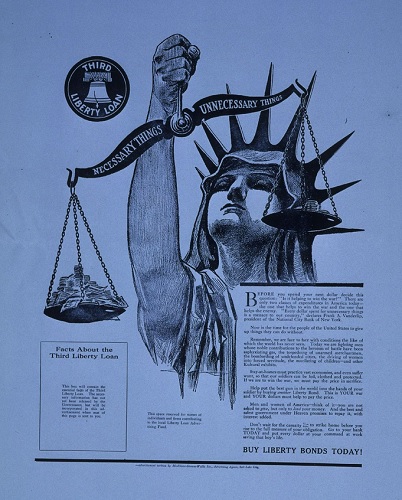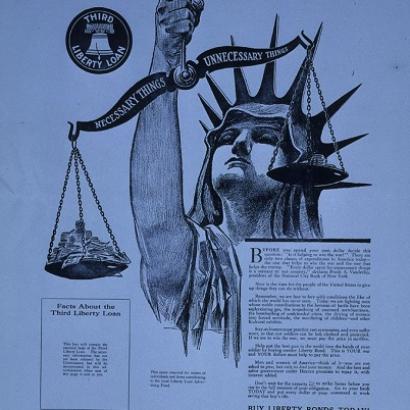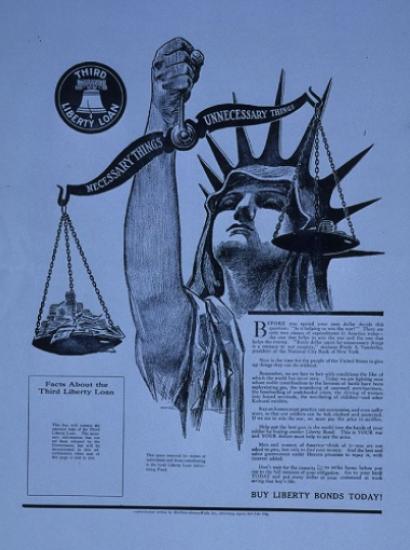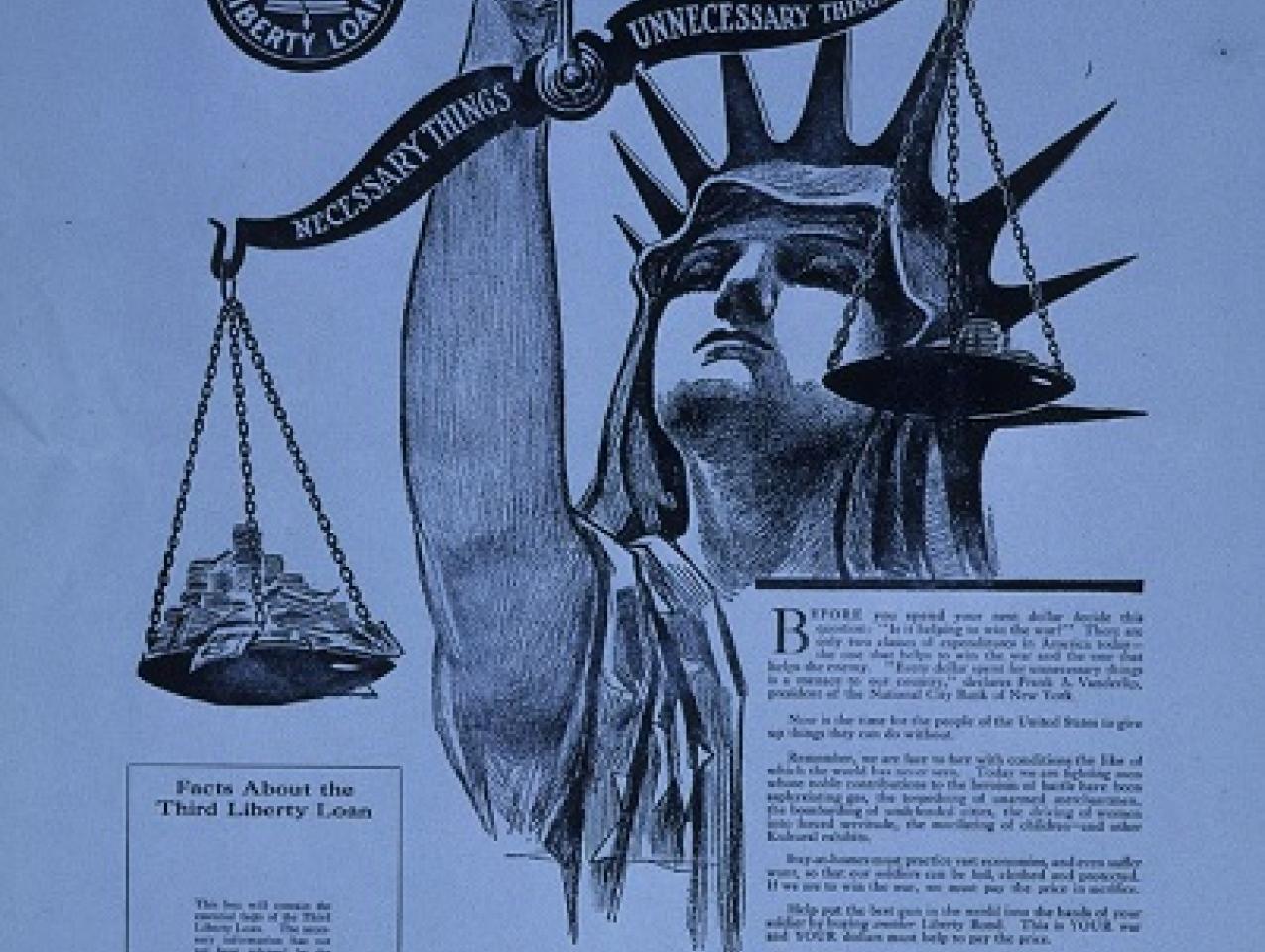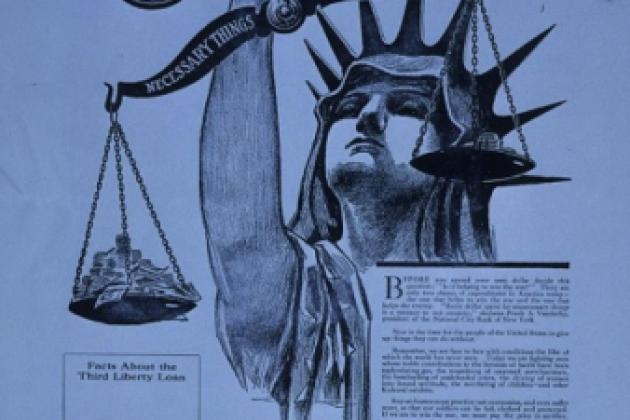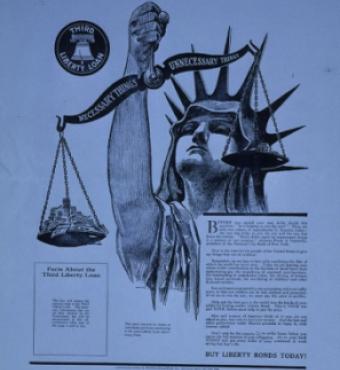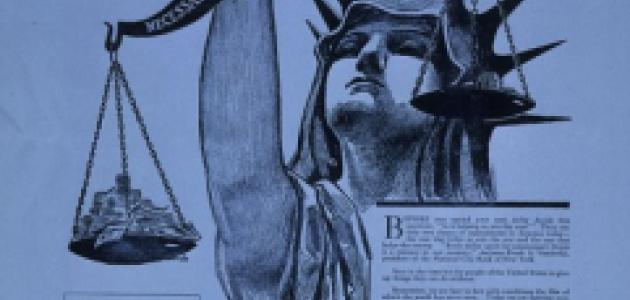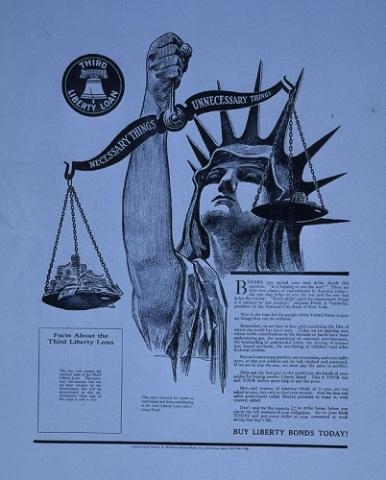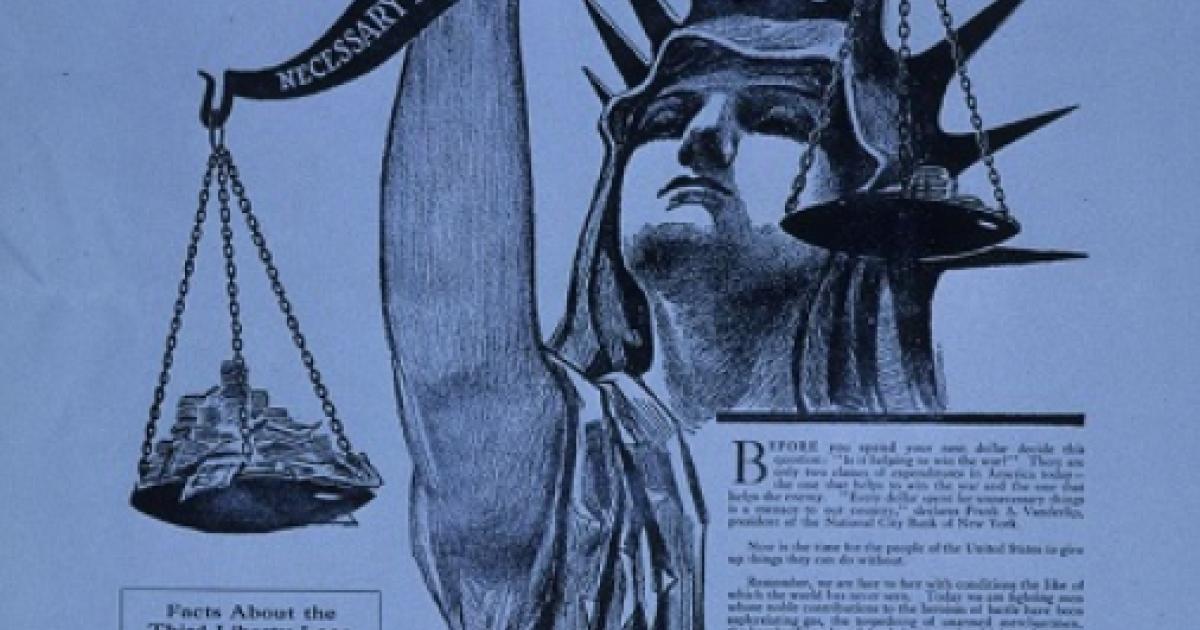By Elise Kostial, Stanford Class of 2018
The democratic principles of liberty and justice are more often associated with the Pledge of Allegiance than with pledges of financial contributions. This World War I–era poster, however, capitalizes on those ideals to encourage readers to purchase war bonds. The message, embodied in the merged image of Lady Liberty and Lady Justice, suggests an artificial unity between the principles of liberty and justice. At the same time, in an attempt to increase bonds sales, it constructs a false dichotomy between frugality and supporting the Axis Powers.
World War I presented the US government with a revenue crisis. Secretary of the Treasury William McAdoo, however, believed that “excessive reliance on taxation would frighten the wealthy and reduce support for the war.” Instead, McAdoo favored encouraging voluntary contributions to the war effort. He developed a strategy of “capitalizing patriotism” through the sale of war bonds called Liberty Bonds. This poster was issued by the US Department of the Treasury’s War Loan Organization between 1917 and 1918 during the third Liberty Bond sales campaign. The poster’s explicit purpose was to encourage its readers to purchase Liberty Bonds, making its targets Americans wishing to aid in the war effort. The poster’s author, the US government, was in a position of authority over the audience it was attempting to influence, the American people. Because the purchase of Liberty Bonds was voluntary, however, the government had to convince the public to buy the bonds for the program to succeed. Nonetheless, throughout the text, the poster maintains an authoritative voice, repeatedly instructing readers that they “must” act. Contributing to that imperative tone is a distinct sense of urgency. Phrases such as “now is the time,” “don’t wait,” and act “today” encourage readers to decide to buy bonds.
The poster frames the purchase of bonds as a moral choice, rather than simply a financial decision, by constructing an artificial unity between the principles of liberty and justice. The poster’s symbolic imagery unmistakably reflects this relationship. Lady Liberty, a common symbol of Liberty, is the prominent figure. Her resolute expression symbolizes freedom, opportunity, and patriotism and thus associates those ideals with the purchasing of Liberty Bonds. Lady Liberty is depicted holding a scale, instead of her usual torch, referencing another well-known symbolic figure, Lady Justice, also known by the Greek name Themis. She is often seen outside of courthouses, blindfolded and holding scales. By constructing this relationship between liberty and justice, the poster lays a visual foundation for its text’s contention that the purchase of Liberty Bonds is the only patriotic and just use for the readers’ extra money.
The association between patriotism and the purchase of Liberty Bonds remains a central theme throughout the poster, implying that the opportunity to buy Liberty Bonds empowers Americans to serve their country. It invites readers to “[h]elp put the best gun in the world into the hands of [their] soldiers.” The poster’s audience, Americans at home, who may have felt powerless to aid in the war effort, gave them the opportunity to purchase Liberty Bonds and thus to make a significant contribution to the cause. The concept of empowering civilians is further emphasized through a militaristic metaphor that refers to Americans’ extra money as dollars “at [their] command.”
The poster also reiterates the relationship between Liberty Bonds and justice in the text, which emphasizes that readers have a moral responsibility to aid in the war effort by purchasing Liberty Bonds. “This is YOUR war and YOUR dollars must help to pay the price,” says the poster, implying that Americans have a personal responsibility to provide funding for the war in addition to their normal responsibilities as taxpayers. The poster entreats readers to “rise to the full measure of [their] obligation.” By the time the third Liberty Loan was initiated, many Americans had already purchased Liberty Bonds. The phrase “full measure,” however, implies that earlier contributions may not have fulfilled that obligation.
In addition to asserting that Americans have a responsibility to buy Liberty Bonds, the poster claims that they have a consequent obligation to exercise frugality when making other financial decisions. “Unnecessary” purchases, weighed on the scales of justice in the image, are presented as unpatriotic and even traitorous. According to the poster, any money that Americans did not spend purchasing “necessary things” to fulfill their daily needs should be used to buy Liberty Bonds. The opening question in the text, “Is [your dollar] helping to win the war?” directs readers’ attention to their personal finances and offers them two potential uses for their spending money: “the one that helps to win the war and the one that helps the enemy,” a choice that presents a false dichotomy between frugality and supporting the Axis Powers. Most readers would not consider giving their money in a way that “helps the enemy”; thus, the only patriotic and just option would appear to be the purchase of bonds. Reinforcing this message, the poster quotes Frank Vanderlip, president of the National City Bank of New York at the time, who stated that “Every dollar spent for unnecessary things is a menace to our country.” This message calls into question the patriotism and moral character of Americans who did not purchase Liberty Bonds.
Clearly, the poster intends to evoke feelings of guilt from Americans who chose not to buy bonds and thus, according to the poster, aided the enemy. The term “stay-at-homes,” used to describe civilians, connotes passivity and tells such “stay-at-homes” that they “must practice vast economies, and even suffer want.” At the same time, the poster juxtaposes the far greater sacrifices made by soldiers overseas. Thus it would seem reasonable that Americans at home should “suffer want” and purchase bonds so that soldiers’ basic needs to be “fed, clothed, and protected” could be met.
Finally, the poster suggests the potential advancement of the Axis Powers, an implied consequence of insufficient bond purchases. At the same time, it appeals to Americans’ fears surrounding the war. “[W]e are face to face with conditions the like of which the world has never seen,” the poster proclaims. With the war framed as an unprecedented circumstance, the consequences of a failed mission could be unimaginable. The text also depicts the enemy in disturbing detail, enumerating the immoral tactics of the Axis Powers, such as the use of “asphyxiating gas, the torpedoing of unarmed merchantmen, the bombarding of undefended cities, the driving of women into forced servitude, the mutilating of children.” If the Allied Powers were unsuccessful, that enemy could reach American shores. Even more tangible is the poster’s reference to the possibility of personal tragedy: “Don’t wait for the causality list to strike home,” the poster warns. Money contributed, it affirms, could be used for “saving that boy’s life.” In particular, this message could prove moving for soldiers’ friends and relatives, wishing to support and protect their loved ones in any way possible.
Mobilizing the nation’s military to engage in World War I was a costly undertaking, and war bonds were a lucrative source of funding. Ultimately, approximately 58 percent of the economic cost of World War I to the United States was funded by borrowing from the public. This poster thus represents one example of the War Loan Organization’s propaganda campaign aimed at motivating Americans to invest in Liberty Bonds. Although the cause advanced by the poster was widely accepted, the ethics of War Loan Organization’s rhetorical strategy are debatable. The poster creates a contrived sense of patriotic and moral obligation to purchase financial securities in the interest of national security.




